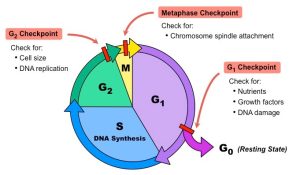
The Regulation of the Cell Cycle: Keeping Cellular Division in Check
The cell cycle is a complex and carefully regulated process that ensures cells divide in a controlled manner. Proper regulation is crucial because mistakes in the duplication of cells can lead to mutations, potentially causing abnormal cells and even cancer. This is why the cell cycle is equipped with numerous checkpoints and regulatory proteins that act as safeguards. Let’s dive into how the cell cycle is monitored and how the body keeps things running smoothly.
Table of Contents
ToggleCell Cycle Checkpoints
To ensure cells divide correctly, the cell cycle has several built-in checkpoints where the process can be halted if conditions aren’t right. These checkpoints occur at key moments to ensure the cell is healthy, DNA is replicated correctly, and the conditions for division are optimal. The major checkpoints are located at the end of G1, at the G2-M transition, and during metaphase.
G1 Checkpoint: This checkpoint occurs at the end of the G1 phase, ensuring the cell is big enough and has the proper proteins and nutrients to proceed to the DNA synthesis phase (S phase). If the cell is not ready, it enters the G0 phase, a resting state where it waits until it receives the necessary signals to re-enter the cycle.
G2 Checkpoint: At the G2 checkpoint, the cell verifies that all DNA has been accurately replicated. If the DNA is intact and ready, the cell progresses to mitosis (M phase).
Metaphase Checkpoint: During metaphase, this checkpoint ensures that all chromosomes are properly aligned, and the mitotic spindle is correctly attached. If everything is in place, the cell proceeds to divide.
These checkpoints are crucial for catching errors that could lead to uncontrolled growth, such as in cancer cells.
Cdk-Cyclin Complex: A Key Regulator

The progression through the cell cycle is largely regulated by a complex known as the Cdk-Cyclin complex. Cyclin-dependent kinases (Cdks) are enzymes that, when combined with proteins called cyclins, help initiate various stages of the cell cycle.
Cyclins accumulate during interphase. As the concentration of cyclins increases and reaches a threshold, it activates Cdk, which drives the cell into mitosis. After mitosis, cyclins are degraded, and Cdk activity is reduced.
Cdk is always present within the cell but is only activated when bound to cyclin, ensuring that the cell doesn’t progress through the cycle unless the appropriate signals are present.
Genes and Proteins in Cell Cycle Regulation
Certain genes and proteins play a critical role in regulating the cell cycle. One such important protein is p53.
p53: The Guardian of the Genome: This protein detects DNA damage caused by factors such as heat, radiation, or chemicals. If p53 detects damage, it stops cell division and activates DNA repair enzymes. If the DNA is beyond repair, p53 will trigger apoptosis (programmed cell death). The role of p53 is so significant that it was named “Molecule of the Year” in 1992 for its contribution to cancer research. When p53 is functioning properly, it prevents the division of cells with damaged DNA. However, if p53 is defective, damaged cells can continue to divide, leading to an increased risk of cancer.
Key Regulatory Genes: There are approximately six key genes that regulate cell division. Mutations in these genes can significantly increase the risk of cancer. These genes are essential for functions like:
Growth Promoter Genes (ON): If these genes remain activated, they lead to unlimited growth.
Tumor Suppressor Genes (OFF): Genes like p53, if turned off, cause the cell to ignore signals to stop, resulting in uncontrolled division.
Apoptosis Genes (OFF): When apoptosis genes are off, cells avoid programmed cell death.
Chromosome Maintenance Genes (ON): These genes, such as telomerase, are essential for unlimited divisions.
Touch-Sensor Gene (OFF): Disabling these genes allows cells to overcome density dependence, continuing to grow despite crowding.
Cancerous Cells: When Regulation Fails
Disruptions in cell cycle regulation can lead to cancer. Cancerous cells divide uncontrollably and have the potential to spread to other parts of the body, a process known as metastasis. Cancer can arise from mutations that keep growth-promoting genes on, inactivate tumor suppressor genes, or prevent apoptosis, leading to unchecked cell proliferation.
The Role of Apoptosis
Apoptosis, or programmed cell death, is a crucial mechanism for maintaining balance within multicellular organisms. This controlled process is important for removing cells that could be harmful, such as cells with DNA damage or those that could become cancerous. During apoptosis, the lysosome releases enzymes that break down cellular components, effectively dismantling the cell.
An example of apoptosis is the peeling of sunburned skin. Damaged skin cells receive the signal for apoptosis to prevent potentially harmful mutations. Without apoptosis, damaged cells could proliferate, increasing the risk of adverse health effects, including cancer.
Maintaining Homeostasis through Regulation
The regulation of the cell cycle is vital for ensuring normal growth and tissue repair while preventing uncontrolled division that leads to cancer. Proteins like p53, as well as checkpoints and regulatory complexes such as Cdk-Cyclin, work together to ensure cells divide correctly or are eliminated if they pose a risk. Understanding these mechanisms is essential for grasping how complex organisms maintain homeostasis and prevent diseases such as cancer.
Recent Posts
- 2.4 Identifying techniques in poetry to analyze literary works
- 2.3 Analyzing word choice to find meaning
- 2.2 Understanding & interpreting meaning in poetic structure
- 2.1 Identifying characters in poetry
- Unit 2 Overview: Introduction to Poetry
- 1.6 The basics of literary analysis
- 1.5 Reading texts literally and figuratively
- 1.4 Understanding and interpreting a narrator’s perspective
- 1.3 Understanding how a story’s structure affects interpretations
- 1.2 Identifying and interpreting setting
- 1.1 Interpreting the role of character in fiction
- Unit 1 Overview: Introduction to Short Fiction
- Laws of Indices – Number & Algebra – IB Mathematics AA HL
- Standard Form – Number & Algebra – IB Mathematics AA HL
- 9.2 Crafting an argument through stylistic choices like word choice and description
Choose Topic
- ACT (17)
- AP (20)
- AP Art and Design (5)
- AP Physics 1 (1)
- AQA (5)
- Artificial intelligence (AI) (2)
- Banking and Finance (6)
- Biology (13)
- Business Ideas (68)
- Calculator (72)
- ChatGPT (1)
- Chemistry (3)
- Colleges Rankings (48)
- Computer Science (4)
- Conversion Tools (136)
- Cosmetic Procedures (50)
- Cryptocurrency (49)
- Digital SAT (3)
- Edexcel (4)
- English (1)
- Environmental Science (2)
- Exam Updates (1)
- Finance (17)
- Fitness & Wellness (164)
- Free Learning Resources (209)
- GCSE (1)
- General Guides (40)
- Health (107)
- History and Social Sciences (152)
- IB (1)
- IGCSE (2)
- Image Converters (3)
- IMF (10)
- Math (39)
- Mental Health (58)
- News (8)
- OCR (3)
- Past Papers (463)
- Physics (5)
- SAT (39)
- Schools (3)
- Sciences (1)
- Short Notes (5)
- Study Guides (28)
- Syllabus (19)
- Tools (1)
- Tutoring (1)

